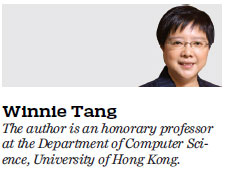More work needed to hasten I&T development
Updated: 2018-10-15 07:33
By Winnie Tang(HK Edition)
|
|||||||
Further to the unprecedented focus on technology and innovation development in last year's Policy Address, the chief executive's continuous commitment to transform the government's technology policy into practice was confirmed in the newly released 2018 Policy Address. First of all, as an I&T practitioner, I welcome the HK$28 billion allocation for the I&T sector.
The focus of this year's I&T section is no doubt on re-industrialization with the CE allocating HK$4 billion for the Re-industrialization Funding Scheme and Hong Kong Science and Technology Parks Corporation to "identify suitable land for building facilities required by the dedicated advanced manufacturing sector". In contrast with last year's policy initiatives, which focused on the upstream of the supply chain, i.e. research and startups, this year's measures encourage downstream production. This will help form a dynamic and healthy ecosystem in Hong Kong.

But I believe more work is needed on the five following aspects in synchronization:
First, the government needs to show a stronger determination on opening data, which is seen as the "new oil" and a driving force of the new economy, and on sharing this with the public. The CE mentioned she had required all government departments to formulate and publish their annual open data plans by the end of this year. But no timeline and detailed plans were available as to how and when to open the data to the public. In fact, the government has collected a large amount of data in its years of operation and should take the lead in opening it, by means of a common spatial data infrastructure. Europe, America and Singapore have long established this kind of platform. But ours will not be fully operational until 2023. This will likely weaken Hong Kong's leading position in inno-tech development. Furthermore, to facilitate applications development, the open data should be available in an application programming interface by default.
Second, to enable civil servants to apply digital technologies to transform public services and on-the-job training to improve their digital competency; this is urgently needed. While we plan to spend eight years establishing a civil service college, Singapore announced in June a five-year Digital Government Blueprint, which will ensure 20,000 or 14 percent of Singapore's public service officers undergo training in data science and data analytics in the next five years. All the ministries are also required to start using artificial intelligence for formulating policies by 2023.
Third, a new Smart Government Innovation Lab (SGI Lab) under the Innovation and Technology Bureau will also be set up - as proposed by the CE. This is to source smart city solutions and then to showcase them. As HKSTP has already set up a Data Studio,this has much open data from the private and public sector for startups to keep testing and fine-tuning until the solutions are ready for the market. Collaboration between SGI Lab and the Data Studio should be facilitated to optimize the effectiveness of the SGI Lab.
Fourth, although the government has introduced various initiatives in the last 12 months, such as the Technology Talent Admission Scheme and the Technology Talent Scheme, we are not competitive enough in terms of attracting global scientific research talents. Every country is fighting for I&T talents. For example, Australia launched a new plan in March to attract highly skilled talent globally; Canada also updated its Global Skills Strategy recently. Australia's Global Talent Scheme allows two types of company to recruit talents from overseas: (1) technology-based or STEM (science, technology, engineering, and mathematics) related startups; (2) Enterprises with an annual turnover of A$4 million ($2.85 million) may also sponsor overseas experienced professionals. These visas last four years; the talents can apply for permanent residency in the third year. As for Canada, its new policy shortens the application time for admitting the inno-tech talents and their family members to only two weeks. Hong Kong has to enhance its attractiveness to overseas talents.
Fifth, innovation should be emphasized in the government procurement process. Currently, assessment of government tender skews toward pricing with weighting of 70 percent. The weighting of technical expertise is only 30 percent. By next April, tenders with innovative suggestions will stand a better chance of winning government contracts as proposed by the CE in her new Policy Address. I suggest the proportion of technical expertise should be over 50 percent to reflect the importance and emphasis on innovation.
Six, the CE promised to raise the research and development expenditure from 0.73 percent of gross domestic product to 1.5 percent in five years' time, and set a goal of HK$45 billion a year in last year's Policy Address. However, only HK$28 billion has been earmarked so far this year. Are we going to make up for the outstanding HK$17 billion later?
Promoting I&T industry allows our workforce, especially the younger generation, to have opportunities for career development with better pay. It is common for the average salary for digital tech jobs to be higher than those in other industries. For example, the starting point for an IT programmer in South Korea can be 50 million won (HK$340,000) a year, 20 percent more than what large business groups offer university graduates; in the UK, IT jobs generally offer 42,578 pounds (about HK$426,000), 31 percent higher than in other sectors.
Of course, these are not easy tasks and it will take time for them to be implemented. But when they are successfully put into place (as a result of stronger government determination and greater effort) Hong Kong will not only move a big step closer to a smart city but also forge ahead with its I&T drive.
(HK Edition 10/15/2018 page8)